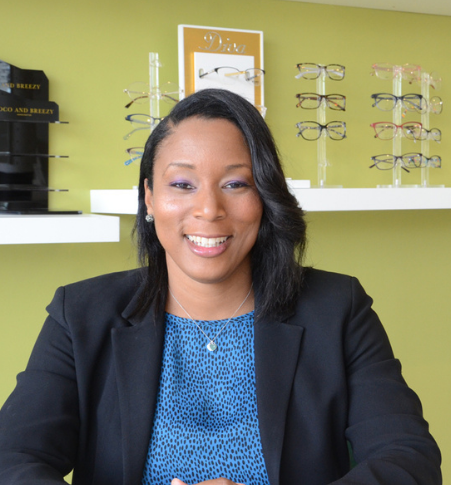You’ve probably heard of astigmatism and myopia, but what are the key differences between these eye conditions? Astigmatism causes blurry vision at all distances, while myopia causes distant objects to look blurry while nearby objects remain clear. Both conditions are kinds of refractive errors.
If you have astigmatism or myopia, prescription eyeglasses or contact lenses can help you see better. Laser surgery is another option. Visit your optometrist for a comprehensive eye exam if you’re experiencing symptoms of either.
Myopia Basics
Otherwise known as nearsightedness, myopia causes objects at a distance to look blurry while objects up close remain clear. This happens due to abnormalities in the eye’s structure. An eye that’s too long, a cornea that’s too curved, or problems with the eye’s lens can cause light to focus in front of the retina instead of directly on it.
Myopia typically begins between the ages of 6 and 14 and stabilizes by a person’s early 20s. A family history of myopia puts you at higher risk of developing it yourself. Children who don’t spend enough time outdoors are also at higher risk of myopia.
Myopia is very common, and more people are developing it. One study estimates that by 2050, half the world’s population will have myopia, and 10% of people will have high myopia.
Astigmatism Basics
Astigmatism happens when the cornea or lens is abnormally shaped. This affects how light refracts and causes vision at all distances to be blurry. Astigmatism may not be noticeable if it’s very mild, which makes an eye exam necessary to confirm the diagnosis. Mild astigmatism may not require treatment.
Some people are born with astigmatism, while others develop it in childhood or young adulthood. Others develop astigmatism after a surgical procedure or eye injury. Unfortunately, astigmatism isn’t preventable, but it’s quite common. According to one estimate, 1 out of 3 people live with astigmatism.

Myopia & Astigmatism: Similarities & Differences
Myopia and astigmatism are both refractive errors. A refractive error happens when the shape of your eye affects the way light bends as it enters, causing blurry vision. According to the National Eye Institute, refractive errors affect over 150 million Americans.
The four main types of refractive error are myopia (nearsightedness), hyperopia (farsightedness), astigmatism, and presbyopia (farsightedness associated with age).
Symptoms
If you have myopia, you may experience:
- Blurry vision when looking at distant objects
- Needing to squint
- Headaches and eyestrain
- Fatigue when using distance vision, such as during sports or when driving
- Attention problems and difficulty with schoolwork among children
Meanwhile, symptoms of astigmatism include:
- Blurry vision overall
- Needing to squint
- Headaches, fatigue, and eye strain
- Seeing halos around lights and experiencing glare
Diagnosis
Myopia can be diagnosed during a comprehensive eye exam. You may be asked to read letters on a chart at varying distances. Your optometrist may also measure how light reflects off your retina using a piece of equipment called a retinoscope. Another device, called a phoropter, is used to measure what prescription power you need.
To check for astigmatism, an optometrist may use a refraction test, keratometry (a test that measures the cornea), or conduct a slit lamp exam. Similar to myopia, you may be asked to read letters off a chart. Astigmatism can also be diagnosed through a dilated eye exam.
Treatment
Both myopia and astigmatism can be treated with eyeglasses and contact lenses. These devices don’t cure refractive errors, but they can help you see more clearly.
Glasses are easy to wear and care for compared to contact lenses, but they may be less convenient in some circumstances. Meanwhile, contact lenses are often chosen by active individuals and those who prefer the way they look without glasses, but contacts require a high degree of care and cleaning. They also take time and practice to get used to.
Laser eye surgery is another option. Used to treat both myopia and nearsightedness, LASIK (laser-assisted in situ keratomileusis) reshapes the cornea and helps create clearer vision. Like any medical procedure, LASIK carries some risks.
Eye surgery is typically performed by ophthalmologists, but optometrists can help you understand whether you’re an appropriate candidate for this procedure. Learn more about our laser eye surgery consultations.
Living With Myopia vs. Living With Astigmatism
Thanks to modern devices like eyeglasses, contact lenses, and even laser surgery, many people with myopia and astigmatism go about life with clear vision.
However, myopia—particularly high myopia—increases the risk of developing more serious eye diseases like retinal detachment and myopic maculopathy. Laser surgery doesn’t remove this problem, as it only reshapes the cornea and doesn’t change the shape of the eye. That’s why myopia control is important for protecting the eye health of children.
Astigmatism can have complications if left untreated. Issues with light and night vision can also pose a safety concern when driving at night.
Understand Your Vision
If you’re experiencing blurry vision, schedule an eye exam. Eye exams aren’t just for checking whether you have a refractive error like myopia or astigmatism; they’re also important for monitoring your eye health. Many eye conditions don’t show obvious symptoms, but early detection means earlier intervention.
Children should receive their first eye exam between the ages of 6 and 12 months. They should have another eye exam between ages 3 and 5, an exam before first grade, and then once a year until they turn 18. Adults generally benefit from an exam every other year, while older adults aged 65 and over should visit the optometrist annually. Some people require more frequent eye exams than these guidelines. If you or your loved one is due for an eye exam, book an appointment at River City Vision Centre. We have locations in Jacksonville and Orange Park, and we welcome your questions on myopia, astigmatism, and other eye conditions.





